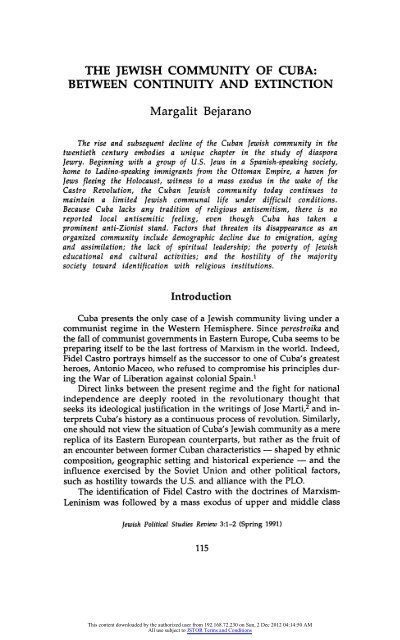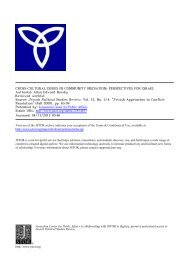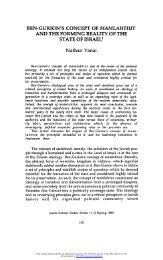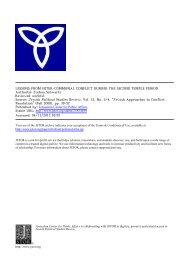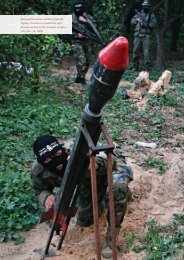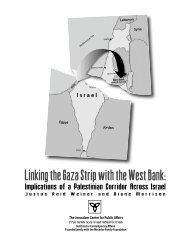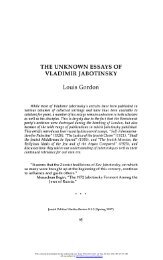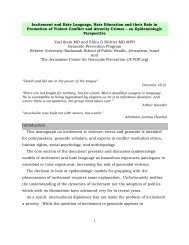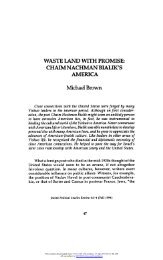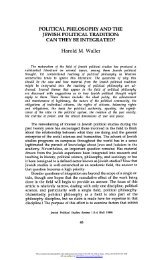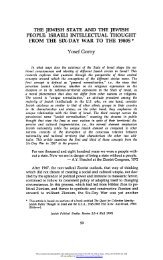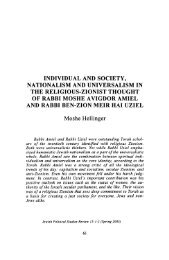the jewish community of cuba: between continuity and extinction
the jewish community of cuba: between continuity and extinction
the jewish community of cuba: between continuity and extinction
You also want an ePaper? Increase the reach of your titles
YUMPU automatically turns print PDFs into web optimized ePapers that Google loves.
The Jewish Community <strong>of</strong> Cuba 117contributed to <strong>the</strong> disconnection <strong>of</strong> <strong>the</strong> chain <strong>of</strong> antisemitism thatcontinued to exist in Europe, transformedby political <strong>and</strong> socialcircumstances into new forms. In Cuba <strong>the</strong> Jewish problem had disappeared,<strong>and</strong> <strong>the</strong> image <strong>of</strong> <strong>the</strong> Jew as <strong>the</strong> crucifier <strong>of</strong> Christ wasconverted into a diabolic mythicalcreature. When Jewish immigrationinto Cubaactually began,Creolesociety refused to identify<strong>the</strong>newcomers as judios (Jews), since <strong>the</strong>y had no horns nor tail.6 In popularuse <strong>the</strong> word"judio" referred to a child before he had been baptized.7The legalbasis for <strong>the</strong> entry <strong>of</strong> Jews into Cuba was formed during<strong>the</strong> military occupation by <strong>the</strong> United States (1898-1902), when <strong>the</strong>principles<strong>of</strong> religiousfreedom <strong>and</strong> separation<strong>between</strong> church <strong>and</strong>state wereoperative also in Cuba. These principles, however, were totally in accordance with <strong>the</strong> opinions <strong>of</strong> <strong>the</strong> founders <strong>of</strong> <strong>the</strong> Cuban republic, many <strong>of</strong> whom had been Freemasons <strong>and</strong> critics <strong>of</strong> <strong>the</strong> CatholicChurch that had opposed Cubanindependence.Unlike o<strong>the</strong>r countriesin Latin America, where separation <strong>between</strong> church <strong>and</strong> state wasreached after protracted conflict <strong>between</strong> liberals <strong>and</strong> conservatives,religion had never been an issue among <strong>the</strong> advocates <strong>of</strong> Cuban freedom,whosepeople <strong>the</strong>y considered "<strong>the</strong> least believing [Catholic people]in<strong>the</strong> wholeglobe."8Thus <strong>the</strong> entry <strong>of</strong> Jewish immigrants into Cuba did not arouse anydormant prejudices, but was ra<strong>the</strong>r acceptedas that <strong>of</strong> any o<strong>the</strong>r European group, accordingto <strong>the</strong> personal impressions <strong>the</strong>yhad made on<strong>the</strong> Cubanpeople<strong>and</strong> to <strong>the</strong> economic <strong>and</strong> politicalcircumstances at<strong>the</strong> time <strong>of</strong> immigration. Jews were nicknamed after <strong>the</strong>ir majorcountries <strong>of</strong> origin: Turcos (Turks) or Polacos (Poles). The image <strong>of</strong> <strong>the</strong> poorPolaco peddler selling ties became part <strong>of</strong> Cuban folklore. The JewishTurcos were not considered a distinct group, but were ra<strong>the</strong>r identifiedwith o<strong>the</strong>rimmigrantsfrom <strong>the</strong> Middle East, mainly Syrians<strong>and</strong>Lebanese, or with <strong>the</strong>ir Ashkenazi co-religionists.Jews never lost <strong>the</strong>ir stigma as Polacos, not even in today's Cubawhere third-generation Jews, many <strong>of</strong> <strong>the</strong>m children <strong>of</strong> mixed marriages,are sometimes still nicknamed Polaco or <strong>the</strong> diminutive Polaquito. Like <strong>the</strong> Gallegos (Spaniards)<strong>and</strong> <strong>the</strong> Chinos (<strong>the</strong> Chinese),<strong>the</strong> Polacos have been recognizedas one <strong>of</strong> <strong>the</strong> minority groups withinCubansociety.9Like o<strong>the</strong>r minority groups, Jews were discriminated against by law<strong>and</strong> bysocial attitudes following <strong>the</strong> rise <strong>of</strong> Cuban nationalism in <strong>the</strong>early 1930s. Xenophobiawastemporarily converted into exsporadicpressions <strong>of</strong> antisemitism as a consequence <strong>of</strong> instigations by agents <strong>of</strong>Nazi Germany.A studyon Cuban antisemitism during<strong>the</strong> period<strong>of</strong> <strong>the</strong>Holocaust concluded that antisemitism was transmitted to Cuba fromEurope <strong>and</strong> found fertile ground among <strong>the</strong> Spanish minority group, butit did not strike roots in <strong>the</strong> Cuban majority society.10Though largely dominated by <strong>the</strong> United States, Cuba had itsThis content downloaded by <strong>the</strong> authorized user from 192.168.72.230 on Sun, 2 Dec 2012 04:14:50 AMAll use subject to JSTOR Terms <strong>and</strong> Conditions
118 Margalit Bejaranospiritualroots in Spain<strong>and</strong> <strong>the</strong> SpanishCivil War waspoliticallyechoed in Cuba. The struggle against Spanish Fascism, identified as<strong>the</strong> successor to <strong>the</strong>ir colonial oppressor, found great support among <strong>the</strong>Cubanpeopleas well as among its leadership;it rested primarilyin<strong>the</strong> Communist Party, legalized<strong>and</strong> later acceptedinto FulgencioBatista's first government (1940-44).11Since <strong>the</strong> days<strong>of</strong> <strong>the</strong> Popular Front, Cuban communists were among<strong>the</strong> defenders <strong>of</strong> <strong>the</strong> Jewish <strong>community</strong> againstantisemitic attacksboth locally <strong>and</strong> internationally. Friendship<strong>between</strong> Jewish <strong>and</strong>Cuban communists consolidated during <strong>the</strong>ir collaboration on behalf <strong>of</strong><strong>the</strong> Allied cause, <strong>and</strong> in particularfor <strong>the</strong> Red Army. The communists'attitude <strong>of</strong> sympathy<strong>and</strong> solidaritytowards <strong>the</strong> Jews, disseminatedduring<strong>the</strong>ir mutualstruggle against Fascism <strong>and</strong> Nazism, was destinedto bear fruit both before <strong>and</strong> after <strong>the</strong> Castro Revolution, <strong>and</strong> shouldnot be overlooked while examining <strong>the</strong> attitude <strong>of</strong> <strong>the</strong> revolutionarygovernment towards <strong>the</strong> Jewish <strong>community</strong>.While <strong>of</strong>ficial antisemitism has never existed in Cuba, Cuban authorities have demonstrated on several occasions a sympa<strong>the</strong>ticattitude towards <strong>the</strong> Jewish people.It seems, however, that Cuba isrecorded in Jewish history mainly through two events ? <strong>the</strong> St. Louistragedy <strong>and</strong> its "no" vote on <strong>the</strong> partition<strong>of</strong> Palestine. Each <strong>of</strong> <strong>the</strong>seepisodes,disconnected from its historical context, tends to distort bothCuba's overall balance in <strong>the</strong> rescue <strong>of</strong> Jewish refugees during <strong>the</strong>Holocaust,12 <strong>and</strong> <strong>the</strong> wide supportin all its political parties for <strong>the</strong>establishment <strong>of</strong> a Jewish state in <strong>the</strong> l<strong>and</strong> <strong>of</strong> Israel.13Thesympa<strong>the</strong>ticattitude towards <strong>the</strong> Jewish people, especiallyamong liberal <strong>and</strong> left-wing intellectuals <strong>and</strong> politicians,found its expressionin <strong>the</strong> friendlyrelations that had developed<strong>between</strong> Cuba<strong>and</strong> <strong>the</strong> State <strong>of</strong> Israel during <strong>the</strong> democratic presidency <strong>of</strong> Carlos PrioSocarras (1948-52) <strong>and</strong> during<strong>the</strong> military dictatorship<strong>of</strong> FulgencioBatista (1952-58).14 It should be stressed that <strong>the</strong> great economicprogress made by local Jews throughout <strong>the</strong> above period, accompaniedby expressions <strong>of</strong> nouvelle richesse, was accepted with great toleranceby <strong>the</strong> Cuban society. This does not imply that social prejudicestowards Jews were non-existent, but <strong>the</strong>ywere mostlylimited to <strong>the</strong>higher social strata who were reluctant to accept Jews to prestigiousclubs or social circles. Among<strong>the</strong> low bourgeoisie <strong>and</strong> poorer classes,who were destined to carry on <strong>the</strong>ir shoulders <strong>the</strong> burden <strong>of</strong> <strong>the</strong> CastroRevolution,antisemitism was a rare phenomenon.15This content downloaded by <strong>the</strong> authorized user from 192.168.72.230 on Sun, 2 Dec 2012 04:14:50 AMAll use subject to JSTOR Terms <strong>and</strong> Conditions
The Jewish Community <strong>of</strong> Cuba 119The History <strong>of</strong> <strong>the</strong> Jewish Immigrants<strong>and</strong> <strong>the</strong>ir InstitutionsThe American GroupJewish immigrationinto Cubabegan with a small group <strong>of</strong> U.S. citizens who settled in Cuba after <strong>the</strong> Spanish-AmericanWar (1898) <strong>and</strong>during<strong>the</strong> first years <strong>of</strong> Cubanindependence.This first nucleus <strong>of</strong>"American" Jews in Cuba was composed mainly <strong>of</strong> Romanian-born Jewswho had lived in sou<strong>the</strong>rn Florida where <strong>the</strong> Cuban movement for independencewas widely supported. Having been naturalized in <strong>the</strong> U.S.<strong>the</strong>y saw <strong>the</strong>mselves as Americans, conducted <strong>the</strong>ir social life in English <strong>and</strong> identified with <strong>the</strong> local American colony. Their first preoccupationas Jews concerned <strong>the</strong> dead: in 1906 a group <strong>of</strong> eleven Jewsformed a societythat wouldprovideburial groundsfor future Jewishsettlers in Cuba. Under <strong>the</strong> name <strong>of</strong> <strong>the</strong> United HebrewCongregationa<strong>the</strong>y purchased largetract <strong>of</strong> l<strong>and</strong> in <strong>the</strong> nearbytown <strong>of</strong> Guanabacoa,where <strong>the</strong> Jewish cemeterywasinauguratedin 1910.16In <strong>the</strong> first period <strong>of</strong> its existence, <strong>the</strong> activities <strong>of</strong> <strong>the</strong> United Hebrew Congregationwere limited to religiousservices during<strong>the</strong> HighHoly Days,held in one <strong>of</strong> Havana's hotels. Confronted with poorSephardic immigrantsfrom <strong>the</strong> Ottoman Empire,<strong>the</strong> American Jewswerecompelledto grant <strong>the</strong>m burial space, but refused to accept <strong>the</strong>Sephardiminto <strong>the</strong>ir congregation.17The arrival <strong>of</strong> U.S.-born Jewish businessmen <strong>and</strong> representatives <strong>of</strong>American firms in Cuba following <strong>the</strong> expansion <strong>of</strong> <strong>the</strong> sugar industryled to <strong>the</strong> organization<strong>of</strong> regular religious services within <strong>the</strong> framework <strong>of</strong> a Reform Templecalled Beth Israel.In 1921, after <strong>the</strong> first U.S. Quota Act, hundreds <strong>of</strong> destitute immigrantsfrom Eastern Europe appearedon <strong>the</strong> streets <strong>of</strong> Havana, <strong>and</strong><strong>the</strong>ir number grew constantly.The small American group, estimated ataround 100 persons,came to <strong>the</strong>ir rescue with great personaldevotion<strong>and</strong> practicallysaved <strong>the</strong>m from starvation.18 Theirphilanthropicmethods, however, werehighly criticized by U.S. welfare organizations that beganto function in Cuba to work directlywith <strong>the</strong> EasternEuropean immigrants. Thus <strong>the</strong> Americans werereplacedas <strong>the</strong>leadership<strong>of</strong> <strong>the</strong> Jewish <strong>community</strong>.A similar story occurred fifteen years later when imported Naziantisemitism threatened <strong>the</strong> security<strong>of</strong> <strong>the</strong> local Jews <strong>and</strong> streng<strong>the</strong>ned a restrictive immigration policy. Refugeesfrom Germany<strong>and</strong>Austria who had found temporary shelter in Cuba found a mutual language with <strong>the</strong> upper middle class American Jews who representedboth <strong>the</strong>ir affluent past <strong>and</strong> <strong>the</strong>ir aspirationto reach <strong>the</strong> UnitedStates. Individual American Jews used <strong>the</strong>ir contacts in governmentThis content downloaded by <strong>the</strong> authorized user from 192.168.72.230 on Sun, 2 Dec 2012 04:14:50 AMAll use subject to JSTOR Terms <strong>and</strong> Conditions
120 Margalit Bejaranocircles in defense <strong>of</strong> <strong>the</strong> whole <strong>community</strong>,but were unable to attain <strong>the</strong>confidence <strong>of</strong> <strong>the</strong> dominant group <strong>of</strong> Eastern European Jews. At <strong>the</strong> sametime <strong>the</strong>y failed to collaborate with <strong>the</strong> Joint Distribution Committee,which had taken <strong>the</strong> responsibilityfor <strong>the</strong> Jewish refugees, <strong>and</strong>, as in<strong>the</strong> early 1920s, <strong>the</strong>ir philanthropywas limited to <strong>the</strong> activities <strong>of</strong><strong>the</strong>ir women's charity.With <strong>the</strong> decline <strong>of</strong> its philanthropic requirements,<strong>the</strong> UnitedHebrewCongregationremained a small upper class group, livingsocially apart from <strong>the</strong> rest <strong>of</strong> <strong>the</strong> Jewish population. Althoughit dominated one <strong>of</strong> <strong>the</strong> basic Jewish necessities ? <strong>the</strong> cemetery, <strong>the</strong> Americangroup did not lead <strong>the</strong> Jewish <strong>community</strong> at large.The Sephardi CommunityAno<strong>the</strong>r Jewish group that arrived in Cuba wascomposed<strong>of</strong>Sephardi Jews, mostly from <strong>the</strong> European parts <strong>of</strong> Turkey. Their immigration began with young men, seeking<strong>the</strong>ir fortune or fleeing militaryservice, who had arrived in Cubaprior to World War I, who would bejoined by<strong>the</strong>ir families soon after <strong>the</strong> war. In 1926 <strong>the</strong>ir number wasestimated at around 4,000: 1,500 in Havana <strong>and</strong> <strong>the</strong> rest in <strong>the</strong> countryside.19 Like o<strong>the</strong>r immigrantsfrom <strong>the</strong> Middle East, mostly Syrian <strong>and</strong>Lebanese Christians, Sephardi Jews dispersed throughout <strong>the</strong> isl<strong>and</strong>,making<strong>the</strong>ir livingas peddlersor petty merchants.SpeakingLadino(Judeo-Spanish), <strong>the</strong>y had no difficultyin assimilatinginto <strong>the</strong> language <strong>of</strong> <strong>the</strong> country.The first organization <strong>of</strong> CubanSephardi Jews, <strong>the</strong> Union HebreaChevet Ahim, was founded in 1914 in order to supply all <strong>the</strong> religious<strong>and</strong> social needs <strong>of</strong> <strong>the</strong> Sephardic immigrants. These includeddailyreligious services, kosher meat <strong>and</strong>charity. Burial groundsweregranted by <strong>the</strong> American Jews. Tourists in today'sHavana can visit <strong>the</strong>original building<strong>of</strong> Chevet Ahim, datingfrom <strong>the</strong> early 1920s, locatedon Inquisidor Street, in <strong>the</strong> quarter <strong>of</strong> Old Havana where new immigrants used to settle.The second center <strong>of</strong> Sephardi social life in Havana, <strong>the</strong> club <strong>of</strong> <strong>the</strong>Union Hebrea Chevet Ahim on <strong>the</strong> Avenida del Prado, hastotallydisappeared.The club, which had served as a second synagogue, usedto hold social <strong>and</strong> cultural activities <strong>and</strong>, from <strong>the</strong> 1930s to <strong>the</strong>Revolution, was consideredby Sephardi parents as <strong>the</strong> best place for<strong>the</strong>ir children to find a Jewish spouse.Chevet Ahim was considered <strong>the</strong> mo<strong>the</strong>r-<strong>community</strong> <strong>of</strong> Sephardiorganizationsin <strong>the</strong> interior, most <strong>of</strong> which were founded in <strong>the</strong> 1920s,<strong>and</strong> it maintained contact with <strong>the</strong>m through<strong>the</strong> yearly supply<strong>of</strong>matzot or joint fundraising campaigns. The two major communities outside Havana were in Camaguey<strong>and</strong> Santiagode Cuba; both had aThis content downloaded by <strong>the</strong> authorized user from 192.168.72.230 on Sun, 2 Dec 2012 04:14:50 AMAll use subject to JSTOR Terms <strong>and</strong> Conditions
The Jewish Community <strong>of</strong> Cuba 121rabbi, a synagogue, <strong>and</strong> a occasionally supplementaryHebrew school.While in HavanaSephardi Jews used <strong>the</strong> cemetery <strong>of</strong> <strong>the</strong> United Hebrew Congregation (until <strong>the</strong>y inaugurated <strong>the</strong>ir own cemeteryin 1942),Sephardi Jews built <strong>the</strong>ir own cemeteries in <strong>the</strong> different provincialtowns, <strong>and</strong><strong>the</strong>y grantedburial facilities to <strong>the</strong>ir Ashkenazibrethren.20Twoimportantfactors determined <strong>the</strong> development<strong>of</strong> <strong>the</strong>Sephardic <strong>community</strong> <strong>of</strong> Cuba: <strong>the</strong> homogenous composition<strong>of</strong> its members <strong>and</strong> <strong>the</strong> presence <strong>of</strong> spiritual-religious leadership.21The most important religious leader, Rabbi Gershon Maya,was a descendant <strong>of</strong> anold rabbinicalfamily from Silivri, <strong>the</strong> <strong>community</strong> <strong>of</strong> origin <strong>of</strong> many <strong>of</strong>Havana'sSephardim.Rabbi Maya'sdevotion to Jewish education aswell as to <strong>the</strong> Zionist movement found expressionin <strong>the</strong> Teodoro Herzlday school that served both <strong>the</strong> Sephardi <strong>community</strong><strong>and</strong><strong>the</strong> ZionistOrganization.Sephardi Jews were among <strong>the</strong> founders <strong>of</strong> <strong>the</strong> Union Sionista ?Cuba's Zionist Organization,<strong>and</strong> for several years <strong>the</strong>y continued tocollaborate with Ashkenazi Jews on behalf <strong>of</strong> <strong>the</strong> Zionist cause, although <strong>the</strong>y were gradually pushed away by <strong>the</strong> Yiddish speakingmajority. This coincided with a growing economic gap <strong>between</strong> <strong>the</strong> twosectors: while Ashkenazipeddlersor workers wereturning into merchants <strong>and</strong> industrialists <strong>and</strong> movinginto better areas <strong>of</strong> residence,many Sephardimcontinued to peddleon Havana's streets.TheEasternEuropeanCommunityImmigrants from Eastern?Europe Pol<strong>and</strong>, Russia, Lithuania, Romania <strong>and</strong>?Hungarywere <strong>the</strong> largest Jewish group that enteredCuba. Their immigration beganin 1921, as a consequence <strong>of</strong> <strong>the</strong> firstU.S. Quota Law, <strong>and</strong> reached a considerable size after <strong>the</strong> JohnsonReed Act <strong>of</strong> 1924. The number <strong>of</strong> those who settled in Cuba was estimated at around 8,000, but several thous<strong>and</strong> o<strong>the</strong>rs passed throughCuba on route to <strong>the</strong> U.S.22The restrictive U.S. immigration policy coincided with a period<strong>of</strong>economic crisis in Cuba. Immigrants from Eastern Europeencounteredgreat difficulties due to <strong>the</strong> general misery<strong>and</strong> unemployment,<strong>the</strong> unfamiliar surroundings <strong>and</strong> <strong>the</strong> difficult climate, <strong>and</strong> <strong>the</strong>ir greatest desire was to proceednorthward to <strong>the</strong> U.S. Until around 1930, <strong>the</strong> CubanAshkenazi populationwas characterized byan unstable existencecaused by <strong>the</strong> strongwaves <strong>of</strong> immigrationfrom Europe<strong>and</strong> emigrationto <strong>the</strong> U.S., but with <strong>the</strong> ultimate closing <strong>of</strong> both Cuba <strong>and</strong> <strong>the</strong> U.S. toimmigration, Jews beganto strike roots in <strong>the</strong>ir new l<strong>and</strong>.Eastern European Jews tended to concentrate in Havana. Some made<strong>the</strong>ir livingas peddlers<strong>of</strong> petty merch<strong>and</strong>ise, o<strong>the</strong>rs begantoThis content downloaded by <strong>the</strong> authorized user from 192.168.72.230 on Sun, 2 Dec 2012 04:14:50 AMAll use subject to JSTOR Terms <strong>and</strong> Conditions
122 Margalit Bejaranomanufacture shoes, shirts, ties or underwear. Since clothing <strong>and</strong> lea<strong>the</strong>rgoods were mostly imported <strong>and</strong> very expensive,<strong>the</strong> cheap productsintroduced by<strong>the</strong> Jews were in high dem<strong>and</strong>, <strong>and</strong> <strong>the</strong> poor tailors <strong>and</strong>shoemakers were soon able to hire newerimmigrantsfor <strong>the</strong>ir sweatshops.23The institutional life <strong>of</strong> <strong>the</strong> Eastern European Jews beganwith a schism <strong>between</strong> <strong>the</strong> workers <strong>and</strong> <strong>the</strong>?"bourgeoisie"in 1925smallmerchants or owners <strong>of</strong> sweatshopswhose economic situation was notmuch better than that <strong>of</strong> <strong>the</strong>ir workers. The former created <strong>the</strong> KulturFarain (Cultural Society), while <strong>the</strong> latter founded <strong>the</strong> Centro Israelita de Cuba (Jewish Center <strong>of</strong> Cuba), both cateringto <strong>the</strong> social <strong>and</strong>spiritual needs <strong>of</strong> <strong>the</strong> Jewish immigrants.The Kultur Farain was considered <strong>the</strong> most active center <strong>of</strong> Jewishcultural <strong>and</strong> social life in <strong>the</strong> late 1920s. It had a large collection <strong>of</strong>books <strong>and</strong> periodicals,a choir, a dramatic circle, <strong>and</strong> provided eveningclasses for its members. Its leaders had close links with <strong>the</strong> CubanCommunist Party, founded in 1925, <strong>and</strong> <strong>the</strong>y joined <strong>the</strong> political struggle against <strong>the</strong> dictatorship<strong>of</strong> Gerardo Machado (1925-1933), five <strong>of</strong><strong>the</strong>m paying with <strong>the</strong>ir lives <strong>and</strong> several o<strong>the</strong>rs being expelledfromCuba.24Jewish presence in <strong>the</strong> early stages <strong>of</strong> Cuba's CommunistPartyaroused <strong>the</strong> interest <strong>of</strong> historians following <strong>the</strong> communist turn in FidelCastro's Revolution.Accordingto <strong>the</strong> minutes <strong>of</strong> <strong>the</strong> foundingsession <strong>of</strong><strong>the</strong> Cuban CommunistParty three out <strong>of</strong> <strong>the</strong> ten founders were Jews;25one <strong>of</strong> <strong>the</strong>m, Yunger Simchowitch, was destined to playa central role in<strong>the</strong> history<strong>of</strong> Cuban communism under <strong>the</strong> name <strong>of</strong> Fabio Grobart. Today,at <strong>the</strong> age <strong>of</strong> 85 <strong>and</strong> still an active member <strong>of</strong> <strong>the</strong> CentralCommittee <strong>of</strong> <strong>the</strong> Cuban Communist Party, Grobart denies his pastlinks with <strong>the</strong> Jewish <strong>community</strong>, but witnesses remember him as <strong>the</strong>most active propag<strong>and</strong>ist among <strong>the</strong> Jewish workers.26While <strong>the</strong> Kultur Farain functioned as an active social center untilit was closed in 1931 by <strong>the</strong> Cuban government, <strong>the</strong> Centro Israelita became <strong>the</strong> leading institution <strong>of</strong> CubanJewryas a result <strong>of</strong> its relationswith Jewish welfareorganizationsin <strong>the</strong> U.S. Social aid from U.S.Jewry was essential to save <strong>the</strong> immigrants from misery <strong>and</strong> to serve<strong>the</strong>ir immediate needs, but it was also intended to convince <strong>the</strong>m to remain in Cuba <strong>and</strong> give up <strong>the</strong>ir American dream.Representatives <strong>of</strong> <strong>the</strong> American Jewish welfare institutions functioning in Cuba directed all <strong>the</strong>ir financial supportto <strong>the</strong> Centro Israelita, hopingto transform it into a comprehensive communalorganization that wouldprovideall <strong>the</strong> social services for <strong>the</strong> Jewish population. Thus<strong>the</strong>y accelerated <strong>the</strong> development<strong>of</strong> local institutionallife, but <strong>the</strong>yalso weakened <strong>the</strong> independence <strong>of</strong> <strong>the</strong> local leadership<strong>and</strong>, in <strong>the</strong> long run, <strong>the</strong> Centro Israelita could not break free <strong>of</strong> its dependenceon U.S. Jewry.This content downloaded by <strong>the</strong> authorized user from 192.168.72.230 on Sun, 2 Dec 2012 04:14:50 AMAll use subject to JSTOR Terms <strong>and</strong> Conditions
The Jewish Community <strong>of</strong> Cuba 123During more than 25 years, <strong>the</strong> Centro Israelita was recognized by<strong>the</strong> Cuban authorities as <strong>the</strong> representative organ <strong>of</strong> <strong>the</strong> Jewish <strong>community</strong>, <strong>and</strong> though<strong>of</strong>ten its leadershipwaschallenged by o<strong>the</strong>r organizations, none <strong>of</strong> <strong>the</strong>m was able to replaceit. At <strong>the</strong> same time, <strong>the</strong>Centro Israelita was <strong>the</strong> central arena for politicalconflicts inside <strong>the</strong><strong>community</strong>; its mostimportant function, however, was <strong>the</strong> maintenance<strong>of</strong> <strong>the</strong> largest Jewish day school.Besides <strong>the</strong> above-mentioned institutions, Eastern European Jewscreated a largenetwork <strong>of</strong> organizations covering every aspect <strong>of</strong> <strong>the</strong>irsocial life.27 Two that continued to have an impacton Jewish life after<strong>the</strong> revolution were Adath Israel <strong>and</strong> <strong>the</strong> Union Sionista.Ashkenaziimmigrantsto Cuba were not characterized bystrict observance <strong>of</strong> Jewish law. A small group <strong>of</strong> Orthodox Jews who assumedresponsibilityfor <strong>the</strong> religiousneeds <strong>of</strong> <strong>the</strong> whole <strong>community</strong> foundedAdath Israel in 1925, <strong>the</strong> mostimportant religious organization<strong>of</strong>Ashkenazi Jews. Due to an old dispute<strong>between</strong> religious activists, agroup <strong>of</strong> Orthodox Jews headed by Rabbi Zvi Kaplanfounded a secondcongregation ? Knesseth Israel. Each maintained a synagogue in <strong>the</strong>same building,on Jesus Maria Street, close to Havana's harbor. Bothprovided religious weddings<strong>and</strong> circumcisions, <strong>and</strong> supervised kosherslaughtering.In addition, Adath Israel founded a Chevra Kadishathat took care <strong>of</strong> <strong>the</strong> religious aspects <strong>of</strong> burial, though <strong>the</strong> cemeteryremained <strong>the</strong> property <strong>of</strong> <strong>the</strong> American Jews.The Zionist Organization<strong>of</strong> Cuba was founded in 1924. Beinga minority among Eastern European Jews, <strong>the</strong> organizationwashighly dependent upon <strong>the</strong> Chevet Ahimcongregation, <strong>and</strong> in its early stagesSephardic Jews were among its most active members. Its founders decided to avoid political divisionsby creatingone Zionist Union?<strong>the</strong>Union Sionista de Cuba. This unitywas maintained in future years: <strong>the</strong>Union Sionista served as <strong>the</strong> ro<strong>of</strong> organization<strong>of</strong> all <strong>the</strong> Zionist movements ? Hechalutz, Hashomer Hatzair, Maccabi <strong>and</strong>, in later years,Betar <strong>and</strong> Hanoar Hazioni.28Conflicts <strong>between</strong> <strong>the</strong> Zionists <strong>and</strong> <strong>the</strong> communists in Cuba reflectsimilar conflicts throughout<strong>the</strong> Jewish world. While <strong>the</strong> majority <strong>of</strong>Ashkenazi Jews belongedto <strong>the</strong> working class, <strong>the</strong> Kultur Farain enjoyed its heyday on <strong>the</strong> Jewish street. The influence <strong>of</strong> Cuban nationalism on <strong>the</strong> Cuban labor movement <strong>and</strong> <strong>the</strong> decrease in <strong>the</strong> number <strong>of</strong>Jewish workers considerablydiminished <strong>the</strong> number <strong>of</strong> Jewish advocates <strong>of</strong> communism, leaving a small, though militant, group. With <strong>the</strong>legalization<strong>of</strong> <strong>the</strong> Cuban Communist Party (1938), Jewish communistsbecame very active, <strong>and</strong> in spite<strong>of</strong> bitter disputeswith <strong>the</strong> Zionistsduring<strong>the</strong> Molotov-Ribbentrop Pact, <strong>the</strong>y regained<strong>the</strong>ir popularityafter Hitler's invasion <strong>of</strong> Russia when <strong>the</strong>ir activities on behalf <strong>of</strong> <strong>the</strong>Red Armywere alignedwith Jewish interests.Zionism,however, wasslowly growing among<strong>the</strong> masses <strong>of</strong> CubanThis content downloaded by <strong>the</strong> authorized user from 192.168.72.230 on Sun, 2 Dec 2012 04:14:50 AMAll use subject to JSTOR Terms <strong>and</strong> Conditions
124 Margalit BejaranoJews who were deeply shakenby <strong>the</strong> horrors <strong>of</strong> <strong>the</strong> Holocaust, inwhich many Cuban Ashkenazi Jews had lost relatives. Witnesses interviewed for an historical study <strong>of</strong> Cuban Jewrytestified about <strong>the</strong>irideologicaltransformation from indifference or oppositionto emphaticsupport for <strong>the</strong> Zionist movement.29 This tendencywashighly accelerated after <strong>the</strong> establishment <strong>of</strong> <strong>the</strong> State <strong>of</strong> Israel.World War II RefugeesDuring <strong>the</strong> period <strong>of</strong> <strong>the</strong> Holocaust, Cuba provided temporaryshelter for almost 12,000 refugees.30Half <strong>of</strong> <strong>the</strong>se refugees, mostlyfromGermany<strong>and</strong> Austria, entered Cuba <strong>between</strong> June 1938 <strong>and</strong> May 1939,using loopholesin Cubanimmigrationlaws <strong>and</strong> semi-<strong>of</strong>ficial arrangements based on graft.31 Although granted temporary residence that formany meant rescue from <strong>the</strong> concentration camps, <strong>the</strong> wererefugeesinconstant danger <strong>of</strong> deportation. Since Cuban law deprived<strong>the</strong>m <strong>of</strong> <strong>the</strong>right to engage in gainful occupations, many <strong>of</strong> <strong>the</strong>m weretotally dependenton <strong>the</strong>ir relatives' supportor on <strong>the</strong> aid <strong>of</strong> <strong>the</strong> Jewish JointDistribution Committee (JDC).32The famous incident <strong>of</strong> <strong>the</strong> ship St. Louis, when more than 1,000Jewish refugees were refused entry into Havana <strong>and</strong> were compelledtoreturn to Europe, resulted in <strong>the</strong> locking<strong>of</strong> Cuba's gates 33 These, however, werereopenedin October 1940, <strong>and</strong> remained open until April1942, thus facilitating<strong>the</strong> rescue <strong>of</strong> over 5,000 Jews from various countries in Central <strong>and</strong> Western Europe. Their entrywas conditionedby<strong>the</strong> payment <strong>of</strong> largesums <strong>of</strong> money to Cuban <strong>of</strong>ficials, so that this outlet was available only to <strong>the</strong> wealthy.34The most dominant group among those who arrived in Cuba <strong>between</strong>1940 <strong>and</strong> 1942 were from Belgium.Unlike <strong>the</strong> refugeesfrom Germany<strong>and</strong> Austria, socially disconnected from <strong>the</strong> local Ostjuden, many <strong>of</strong> <strong>the</strong>Belgian Jews were originallyfrom Pol<strong>and</strong> <strong>and</strong> <strong>the</strong>y participatedin <strong>the</strong>local organizations,a giving special impulseto <strong>the</strong> development <strong>of</strong> <strong>the</strong>Zionist movement. Their strongest impactwas <strong>the</strong> establishment <strong>of</strong> <strong>the</strong>diamondindustry, encouraged by Cuba's government, that providedapr<strong>of</strong>itable source <strong>of</strong> income for both refugees <strong>and</strong> veteran Jews 35After World War II, previous diamond centers were rehabilitated,<strong>and</strong> <strong>the</strong> small Belgian colonyin Cuba ei<strong>the</strong>r returned to Antwerporemigratedto New York. O<strong>the</strong>r Jewish refugees were graduallyable toenter <strong>the</strong> U.S.through <strong>the</strong> quotas <strong>of</strong> <strong>the</strong>ir countries <strong>of</strong> origin, especiallywhenemigration from Europecame almost to a stop during<strong>the</strong> war. Thelarge colony<strong>of</strong> Jewish refugees eventually disappearedwithout atrace, its only imprint beinga few graves in <strong>the</strong> Guanabacoa cemeterycarrying German inscriptions.This content downloaded by <strong>the</strong> authorized user from 192.168.72.230 on Sun, 2 Dec 2012 04:14:50 AMAll use subject to JSTOR Terms <strong>and</strong> Conditions
The Jewish Community <strong>of</strong> Cuba 125The Jewish Community Under Batista'sMilitary DictatorshipThoughmarked by violent political repression, <strong>the</strong> militarydictatorship <strong>of</strong> FulgencioBatista (1952-1958) brought prosperityto <strong>the</strong>economic sectors into which <strong>the</strong> Jews had beenintegrated. SephardiJews, formerly dispersed throughout<strong>the</strong> isl<strong>and</strong>, centered in <strong>the</strong> maincities, especiallyin Havana. In <strong>the</strong> capital, <strong>the</strong> once poor immigrants<strong>of</strong> Old Havana moved into better residential areas such as SantosSuarez, Vedado, or <strong>the</strong> elegantMiramar. While <strong>the</strong> majoritywere engagedin commerce <strong>and</strong> industry, many among <strong>the</strong> second generation,Ashkenazim <strong>and</strong> Sephardim alike, acquired highereducation <strong>and</strong>turned to <strong>the</strong> liberal pr<strong>of</strong>essions.36Jews did not interfere in political matters, since <strong>the</strong> process <strong>of</strong> <strong>the</strong>irassimilation within Cuban society was only at its beginning. A group <strong>of</strong>young intellectuals founded <strong>the</strong> Agrupacion Cultural Hebreo-Cubana inorder to encourage underst<strong>and</strong>ing<strong>between</strong> Jews <strong>and</strong> Cubans. Among Jewish university students, however, only a small minority were engagedin <strong>the</strong> revolutionary underground movement.37 Jewish communists hadbeen active in Cuban politics, but duringthis period <strong>the</strong>y almost totally disappearedfrom <strong>the</strong> Jewish arena, following<strong>the</strong> repression <strong>of</strong><strong>the</strong> Communist Party <strong>and</strong> disappointmentwith <strong>the</strong> Soviet Union'spolicytoward Israel <strong>and</strong> <strong>the</strong> Jews.Since <strong>the</strong> establishment <strong>of</strong> <strong>the</strong> State <strong>of</strong> Israel, <strong>the</strong> Jewish <strong>community</strong> experienceda Zionist revival. Activities on behalf <strong>of</strong> <strong>the</strong> Jewishstate were <strong>the</strong> axis <strong>of</strong> Jewish communal life, <strong>and</strong> <strong>the</strong>ir economic prosperity expresseditself in generous contributions to <strong>the</strong> Israel Bond drive<strong>and</strong> o<strong>the</strong>r Zionist campaigns. Diplomaticrelations <strong>between</strong> Cuba <strong>and</strong>Israel, established in 1954, streng<strong>the</strong>ned<strong>the</strong> self-confidence <strong>of</strong> <strong>the</strong> local Jews. Friendship<strong>between</strong> <strong>the</strong> two countries was reflected in <strong>the</strong>planting <strong>of</strong> <strong>the</strong> Jose Marti Forest in <strong>the</strong> Judean hills <strong>and</strong> <strong>the</strong> naming <strong>of</strong> aHavana school "Estado de Israel."38 Sender Kaplan,<strong>the</strong> president<strong>of</strong><strong>the</strong> Union Sionista, functioned as HonoraryConsul <strong>of</strong> Israel (19511960); thus he wasrecognizedas both <strong>the</strong> diplomatic representative<strong>of</strong><strong>the</strong> State <strong>of</strong> Israel <strong>and</strong> <strong>the</strong> main leader <strong>of</strong> <strong>the</strong> Jewish <strong>community</strong>.An important consequence <strong>of</strong> both economic prosperity<strong>and</strong> self-confidence was a movement <strong>of</strong> exhibitionist construction <strong>of</strong> new buildingsfor <strong>the</strong> Jewish institutions. The most salient among <strong>the</strong>m was <strong>the</strong> Patronato ? Casa de la Comunidad Hebrea de Cuba (House <strong>of</strong> <strong>the</strong> JewishCommunity <strong>of</strong> Cuba), situated on 13th <strong>and</strong> I Streets in Vedado. The Patronato was initiated bya group <strong>of</strong> rich Jews, <strong>and</strong> designed by <strong>the</strong> famous Cuban architect Aquiles Capablanca.It wasinauguratedin October 1955 in <strong>the</strong> presence <strong>of</strong> President Batista, Prime MinisterJorge Garcia Montes, <strong>and</strong> o<strong>the</strong>r high <strong>of</strong>ficials.39The Patronato was designedto replace<strong>the</strong> Centro Israelita de CubaThis content downloaded by <strong>the</strong> authorized user from 192.168.72.230 on Sun, 2 Dec 2012 04:14:50 AMAll use subject to JSTOR Terms <strong>and</strong> Conditions
126 Margalit Bejaranoas <strong>the</strong> representative organ <strong>of</strong> <strong>the</strong> Jewish <strong>community</strong>, <strong>and</strong> its buildingreflected <strong>the</strong> transformation <strong>of</strong> Cuban Jews from <strong>the</strong>ir as apositiongroup <strong>of</strong> immigrants, strugglingfor survival in a foreign l<strong>and</strong>, to that <strong>of</strong>an established colony, well-rooted in <strong>the</strong> generalmiddle class. Thelarge building<strong>of</strong> <strong>the</strong> Patronato was divided <strong>between</strong> a beautiful modern synagogue <strong>and</strong> a social <strong>and</strong> cultural center, whose main hall had acapacity<strong>of</strong> 1,250 seats.40 The magnificent building,noticeable fromafar byits higharch <strong>and</strong> decorated with Jewish emblems, symbolized<strong>the</strong> self-deceptive tranquillity<strong>and</strong> confidence <strong>of</strong> <strong>the</strong> Jewish <strong>community</strong>in its future.Members <strong>of</strong> <strong>the</strong> Orthodox group, ga<strong>the</strong>redaround Adath Israel,preferredto erect <strong>the</strong>ir own buildingin Old Havana, where many <strong>of</strong><strong>the</strong>m still lived.41 On <strong>the</strong> corner <strong>of</strong> Picota <strong>and</strong> Acosta Streets <strong>the</strong>yconstructed a three-story building containinga large synagogue (600 seats),a reception hall, a small synagogue for <strong>the</strong> daily minyan,<strong>and</strong> a mikve.The building<strong>of</strong> <strong>the</strong> Patronato <strong>and</strong> <strong>the</strong> new Adath Israel served asmodels to <strong>the</strong> Sephardisector. Upperclass Sephardim livinginVedado <strong>and</strong> Miramar wished to establish a neworganizationthatwould fit <strong>the</strong>ir new social position. Theyfounded a new congregation,Centro Hebreo Sefaradi, that constructed a beautiful synagogue <strong>and</strong> social center on 17th <strong>and</strong> E Streets in Vedado. The building<strong>of</strong> <strong>the</strong> CentroSefaradi was accompanied by conflicts with <strong>the</strong> Sephardim <strong>of</strong> OldHavana who were faithful to <strong>the</strong> primacy<strong>of</strong> Chevet Ahim. However,<strong>the</strong> Castro Revolution occurred before <strong>the</strong> Sephardimhad time toproperly inaugurate<strong>the</strong>ir new center <strong>and</strong> to redefine <strong>the</strong> relationship<strong>between</strong> <strong>the</strong> new Centro Sefaradi <strong>and</strong> <strong>the</strong> old Chevet Ahim.The first Jewish organizationin Cuba, <strong>the</strong> United HebrewCongregation, was <strong>the</strong> last to be caught by <strong>the</strong> construction fever. In 1956, after<strong>the</strong> celebration <strong>of</strong> <strong>the</strong> congregation's fiftieth anniversary, AmericanJews were about to purchasea piece<strong>of</strong> l<strong>and</strong> on Miramar's Fifth Avenue<strong>and</strong> 32nd Street. Their projectnever materialized, however. When <strong>the</strong>Revolution occurred, American Jews were among <strong>the</strong> first to leave Cuba<strong>and</strong> return to <strong>the</strong> U.S., which<strong>the</strong>y considered as <strong>the</strong>ir homel<strong>and</strong>.The Attitude <strong>of</strong> <strong>the</strong> Revolutionary Governmenttoward <strong>the</strong> JewsThe Cuban Revolution, which took power on 1 January 1959, broughtabout <strong>the</strong> total destruction <strong>of</strong> <strong>the</strong> former economic, political <strong>and</strong> socialstructure in which <strong>the</strong> Jewish <strong>community</strong> had prospered.Nationalization <strong>of</strong> private business, economicprivations,<strong>and</strong> Fidel Castro's openidentification with Marxist-Leninistideology were among <strong>the</strong> causes<strong>of</strong> <strong>the</strong> large-scale emigration<strong>of</strong> upper <strong>and</strong> middle class CubansThis content downloaded by <strong>the</strong> authorized user from 192.168.72.230 on Sun, 2 Dec 2012 04:14:50 AMAll use subject to JSTOR Terms <strong>and</strong> Conditions
The Jewish Community <strong>of</strong> Cuba 127including<strong>the</strong> majority<strong>of</strong> Cuban Jews, whose number declined from10,000-12,000 in 1959 to 1,200 in 1963.42A large number <strong>of</strong> Cuban Jews had emigratedto <strong>the</strong> U.S.; like o<strong>the</strong>rCubanemigrants, <strong>the</strong>y were treated by <strong>the</strong> new governmentas enemies<strong>of</strong> <strong>the</strong> revolution, <strong>the</strong>ir propertywas confiscated <strong>and</strong><strong>the</strong>y were allowed to take along onlya minimal number <strong>of</strong> personal belongings. Jewsleaving for Israel were aided by <strong>the</strong> Jewish Agency<strong>and</strong> <strong>the</strong> IsraeliLegation,<strong>and</strong> were granted <strong>the</strong> respect <strong>and</strong> sympathy<strong>of</strong> <strong>the</strong> Cuban authorities, though onlya small number chose <strong>the</strong> Zionist solution.43 Themajority, including<strong>the</strong> Zionist leaders <strong>of</strong> <strong>the</strong> <strong>community</strong>, settled inMiami.The Jews remainingin Cuba were allowed to maintain all <strong>the</strong>irformer institutions. These included five congregations: <strong>the</strong> United Hebrew Congregation<strong>of</strong> <strong>the</strong> American Jews, <strong>the</strong> Patronato <strong>and</strong> Adath Israel <strong>of</strong> <strong>the</strong> Ashkenazi sector, <strong>and</strong> <strong>the</strong> Centro Sefaradi <strong>and</strong> ChevetAhim <strong>of</strong> <strong>the</strong> Sephardim. The government did not attemptto confiscate<strong>the</strong>se buildings, although<strong>the</strong> number <strong>of</strong> <strong>the</strong>ir members had severelydeclined. Moises Baldas, who served as <strong>the</strong> leading Jewish activistafter <strong>the</strong> Revolution (until his emigrationto Israel in 1981), organizedan informal committee composed<strong>of</strong> <strong>the</strong> presidents <strong>of</strong> <strong>the</strong> five congregations in order to coordinate <strong>the</strong>ir activities <strong>and</strong> represent <strong>the</strong> Jewish<strong>community</strong> before <strong>the</strong> authorities. The Comision Coordinadora(Coordinating Committee) became <strong>the</strong> de facto ro<strong>of</strong> organization <strong>of</strong>CubanJewry.44Following<strong>the</strong> Revolution, <strong>the</strong> Jewish <strong>community</strong> was granted special privilegesto supplyits religious needs, such as kosher food <strong>and</strong>Jewish education. The shochet <strong>of</strong> Adath Israel was allowed to functionin <strong>the</strong> government slaughtering house, <strong>and</strong> <strong>the</strong> meat was divided <strong>between</strong> <strong>the</strong> kosher restaurant <strong>of</strong> <strong>the</strong> Patronato <strong>and</strong> Jewish customers whowere allowed to receive <strong>the</strong>ir meat rations at <strong>the</strong> kosher butcher. Inaddition, <strong>the</strong> <strong>community</strong>was allowed to receive matzot <strong>and</strong> o<strong>the</strong>rproducts for Pessach from abroad.The nationalization <strong>of</strong> educationbroughtabout <strong>the</strong> closure <strong>of</strong> allprivate schools. Jews, however, weregranted special permissiontoprovide Jewish education within <strong>the</strong> government system. The school <strong>of</strong><strong>the</strong> Centro Israelita was named after Albert Einstein <strong>and</strong> converted to aregular neighborhoodschool. In addition, it provided dailyclasses inHebrew, Yiddish <strong>and</strong> Jewish history, <strong>and</strong> <strong>the</strong> government suppliedtransportationfor <strong>the</strong> Jewish children.45 This arrangementfunctioneduntil 1975, when it wassuddenly stopped by government order46It should be recalled that <strong>the</strong> regulationsunder which <strong>the</strong> Jewish<strong>community</strong> functioned were formed during <strong>the</strong> first period <strong>of</strong> <strong>the</strong> Revolution, while Cuba maintained friendlyrelations with <strong>the</strong> State <strong>of</strong> Israel, <strong>and</strong> <strong>the</strong> Jewish <strong>community</strong>felt somewhat protected by<strong>the</strong> IsraeliThis content downloaded by <strong>the</strong> authorized user from 192.168.72.230 on Sun, 2 Dec 2012 04:14:50 AMAll use subject to JSTOR Terms <strong>and</strong> Conditions
128 Margalit BejaranoLegation.Fidel Castro's initial sympathytowards Israel <strong>and</strong> <strong>the</strong> Jewish peoplehas been explained bysome scholars as stemmingfrom his?political backgroundconsolidated in an anti-Nazi <strong>and</strong> anti-Francoatmosphere,in his close personallinks with Ricardo Subirana y Lobo?Cuba's Ambassador to Israel, in <strong>the</strong> image <strong>of</strong> Israel as a small country surrounded by enemies <strong>and</strong> guided by a socialist leadership,as wellas in Castro's desire to maintainpolitical independencevis-a-vis <strong>the</strong>Soviet Union.47Cuba's resistance to strong political pressures to terminate diplomatic relations with Israel after <strong>the</strong> Six-DayWarchangedwith Castro's sudden announcementbreaking relations with Israel at <strong>the</strong>Conference <strong>of</strong> Non-AlignedNations in Algiersin September1973. Since<strong>the</strong>n Cuba has become one <strong>of</strong> <strong>the</strong> most vociferous attackers <strong>of</strong> Israelboth in its local media <strong>and</strong> in <strong>the</strong> international arena. In 1975 it wasone <strong>of</strong> <strong>the</strong> sponsors <strong>of</strong> <strong>the</strong> U.N. General Assembly'sresolution equatingZionism with racism.48 Animportant consequence <strong>of</strong> Cuba's international positiontowards Zionism was <strong>the</strong> closure in 1978 <strong>of</strong> <strong>the</strong> UnionSionista de Cuba, which had continued to function in Havana. Thebuilding was givenCuba.to <strong>the</strong> PLO <strong>and</strong> converted into <strong>the</strong> Union Arabe deOfficiallyCuba maintains a clear distinction <strong>between</strong> Zionism <strong>and</strong>Judaism; while <strong>the</strong> former is attacked dailyin <strong>the</strong> mass media, antisemitism is strictly forbidden by law.49 Never<strong>the</strong>less, some publications carrya clear tinge <strong>of</strong> antisemitism, stemming from Soviet or Arabsources. Attacks against Israel were particularly strong during <strong>the</strong> government <strong>of</strong> MenachemBegin, depictedin Cuban cartoons as "a dogwearinga collar with a swastika."50 O<strong>the</strong>rexamples may be found inbooks such as that <strong>of</strong> Abu Mazzen, The Truth on Secret Relations Betxveen Nazism <strong>and</strong> Zionism.51 In his studyon "Cuban Jews during 30Years <strong>of</strong> Revolution," Moises Asis qualifies<strong>the</strong> antisemitic deviationsas exceptionsto <strong>the</strong> Cuban rule "not to confuse information or propag<strong>and</strong>a againstIsrael with negativehints against<strong>the</strong> Jewish People,itsreligion, culture or history."52Asis' view should not be taken as lipservice to <strong>the</strong> authorities;nei<strong>the</strong>r <strong>the</strong> Jewish <strong>community</strong>nor individual Jews had been victims <strong>of</strong>discrimination. DavidKopilowwrote that "It is difficult to avoiddrawing<strong>the</strong> conclusion that <strong>the</strong> <strong>of</strong>ficial anti-Zionist st<strong>and</strong> <strong>of</strong> <strong>the</strong> government on international questionshas translated into a callousness <strong>and</strong>hostility towards <strong>the</strong> Cuban-Jewish <strong>community</strong>that can be called antiSemitic,"53 but he does not <strong>of</strong>fer evidence to substantiate his conclusion.This author is convinced that nei<strong>the</strong>r <strong>of</strong>ficial nor social antiSemitism exists in Cuba, <strong>and</strong> that <strong>the</strong> government makes a cleardistinction <strong>between</strong> its policytowards Israel, based on politicalconsiderations, <strong>and</strong> its attitude towards <strong>the</strong> Jewish <strong>community</strong>.Thelatter is a combination <strong>of</strong> several factors:ideological principlesThis content downloaded by <strong>the</strong> authorized user from 192.168.72.230 on Sun, 2 Dec 2012 04:14:50 AMAll use subject to JSTOR Terms <strong>and</strong> Conditions
The Jewish Community <strong>of</strong> Cuba 129opposing any discrimination against minorities; sensitivitytowardsinternational public opinion, that examines <strong>the</strong> Jewish <strong>community</strong>as atest case <strong>of</strong> religious freedom; traditionalsympathytowards <strong>the</strong>Jewish <strong>community</strong>;<strong>and</strong> <strong>the</strong> continuation <strong>of</strong> previousbureaucraticarrangements, established in <strong>the</strong> early 1960s.54It should be added that <strong>the</strong> special attitude <strong>of</strong> Cuba's communistgovernment towards <strong>the</strong> Jewish <strong>community</strong>,as well as towards o<strong>the</strong>rreligious groups, cannot be explainedwithouttakinginto account <strong>the</strong>personality<strong>of</strong> Dr. Jose Felipede Carneado, head <strong>of</strong> <strong>the</strong> Oficina deAsuntos Religiosos (Office <strong>of</strong> Religious Matters) in <strong>the</strong> Central Committee <strong>of</strong> <strong>the</strong> Cuban CommunistParty. Born in a provincial town, wellrooted in Cuban tradition, Carneado waspolitically educated among<strong>the</strong> old-time communists. He became an ardent supporter <strong>of</strong> <strong>the</strong>Revolution, but maintained a deep respect for popularCuban tradition<strong>and</strong> beliefs. For almost 30 years he has been responsiblefor all religiousmatters in Cuba. One <strong>of</strong> his greatest achievements was to create a cleardistinction <strong>between</strong>religion <strong>and</strong> politics, especiallyin <strong>the</strong> case <strong>of</strong> <strong>the</strong>Catholic Church, wherestruggles against anti-revolutionaryforceswereintermingled with suppression<strong>of</strong> religion. Carneado's tolerance<strong>and</strong> openness resulted in <strong>the</strong> special modus vivendi existent in Cuba,wherereligious groups that accept <strong>the</strong> government's rules not to identifywith Cuba's opponentsare grantednot only <strong>of</strong>ficial tolerance, butare practically protected by<strong>the</strong> Office <strong>of</strong> Religious Matters in <strong>the</strong> provision <strong>of</strong> all <strong>the</strong>ir needs.55 The Jewish <strong>community</strong>is onlyone such example.The Present Situation56The number <strong>of</strong> Cuban Jews today is estimated around 1,000. The onlyavailable data is <strong>the</strong> annual Passover census, carried out by <strong>the</strong> Coordinating Committee. Accordingto Asis' calculations, based on <strong>the</strong> 1989census, 892 persons subscribed in <strong>the</strong> Jewish <strong>community</strong>for matzot <strong>and</strong>o<strong>the</strong>r kosher products. Of <strong>the</strong>se, 635 were Jews <strong>and</strong> <strong>the</strong> rest were nonor o<strong>the</strong>r persons livingin <strong>the</strong> same household.57 TheJewish spouseslarge number <strong>of</strong> non-Jews is explained by<strong>the</strong> fact that scarcity <strong>of</strong> foodmakes it impossibleto discriminate <strong>between</strong> Jews <strong>and</strong> non-Jews whiledistributing foodstuffs to people livingunder <strong>the</strong> same ro<strong>of</strong>. On <strong>the</strong>o<strong>the</strong>r h<strong>and</strong> it is assumed that a largenumber <strong>of</strong> Jews refrain from subscription in <strong>the</strong> Jewish <strong>community</strong> because <strong>of</strong> <strong>the</strong>ir communist convictions, or <strong>the</strong>ir fear to identify openly with <strong>the</strong> Jewish <strong>community</strong>.Cuban Jews do not constitute a separate socio-economic group, <strong>and</strong><strong>the</strong>y are well-assimilated within <strong>the</strong> general society. Twenty percent<strong>of</strong> <strong>the</strong> persons counted in <strong>the</strong> <strong>community</strong>'scensus worked in <strong>the</strong> pr<strong>of</strong>essions, <strong>and</strong> <strong>the</strong>ir number among those not identified with <strong>the</strong> <strong>community</strong>This content downloaded by <strong>the</strong> authorized user from 192.168.72.230 on Sun, 2 Dec 2012 04:14:50 AMAll use subject to JSTOR Terms <strong>and</strong> Conditions
130 Margalit Bejaranois assumed to be higher.58A small number <strong>of</strong> Jews, mostly Sephardim,live in <strong>the</strong> interior towns, but <strong>the</strong> majorityis centered in <strong>the</strong> capital.Apartfrom a relatively large number <strong>of</strong> old peoplestill livingin OldHavana, Jews are dispersed throughout<strong>the</strong> city, whereas priorto <strong>the</strong>Revolution <strong>the</strong>y tended to concentrate in distinct areas. One <strong>of</strong> <strong>the</strong>problems facing <strong>the</strong> <strong>community</strong>is to provide transportationfor <strong>the</strong>Jewish school or o<strong>the</strong>r activities because <strong>of</strong> <strong>the</strong> large geographicdistances.Four out <strong>of</strong> <strong>the</strong> five are religious congregationsstill functioninginHavana. The Reformtemple <strong>of</strong> <strong>the</strong> American Jews, on Avenida de losPresidentes (in Vedado), continued to function until around 1980 when itwas sold to <strong>the</strong> government for lack <strong>of</strong> members; <strong>the</strong> buildingis now undergoingreconstruction by<strong>the</strong> Cuban state.The property<strong>of</strong> <strong>the</strong> United Hebrew Congregationwas on passedtoAdath Israel, but <strong>the</strong> organizationhas not been formally dissolved; ithas a Board <strong>of</strong> Directors that meetsregularly,to fulfill <strong>of</strong>ficialobligations.Since <strong>the</strong> nationalization <strong>of</strong> <strong>the</strong> cemeteries in 1967, <strong>the</strong>state has assumed responsibilityfor burial expenses, but <strong>the</strong> UnitedHebrewCongregationcontinues to be recognizedas <strong>the</strong> manager <strong>and</strong>proprietor <strong>of</strong> <strong>the</strong> cemetery that had been once <strong>the</strong> cornerstone <strong>of</strong> Jewishinstitutional existence in Cuba.Chevet Ahim is <strong>the</strong> only Jewish organizationstill functioningin itsoriginal premises,<strong>and</strong> it remained throughout <strong>the</strong> years as <strong>the</strong> center<strong>of</strong> <strong>the</strong> Sephardim livingin Old Havana, many <strong>of</strong> whom continued towork as peddlersuntil privatecommerce was prohibited.While many<strong>of</strong> <strong>the</strong> Jews who remained in Cuba after <strong>the</strong> Revolution received compensation for <strong>the</strong>ir nationalized property or found employmentin government-owned establishments, <strong>the</strong> poor Sephardi peddlers,who didnot pr<strong>of</strong>it from <strong>the</strong> economicopportunitiesunder Batista, lackedinitiative to leave Cuba <strong>and</strong> were unable to adjustto <strong>the</strong> revolutionaryregime.Some <strong>of</strong> <strong>the</strong>m remained with no source <strong>of</strong> income <strong>and</strong> have sincebeen livingon <strong>the</strong> small subvention distributed by <strong>the</strong> local Jewish institutions.Chevet Ahim continued to serve as a social <strong>and</strong> religiouscenter aslong as it had an active leadership.Since its guiding spirit, JacoboPerez, was taken ill, <strong>the</strong> situation <strong>of</strong> <strong>the</strong> Sephardi organizationhasbeen constantly deteriorating,<strong>and</strong> since <strong>the</strong> death <strong>of</strong> <strong>the</strong> haham Susi in1986, <strong>the</strong>re is no one capable <strong>of</strong> conducting religiousservices.For several years <strong>the</strong> government permitted<strong>the</strong> functioning<strong>of</strong> abar, <strong>and</strong> revenues from <strong>the</strong> sale <strong>of</strong> beer financed <strong>the</strong> social activities <strong>of</strong>Chevet Ahim. Now <strong>the</strong> old Sephardi organizationis totally dependent on <strong>the</strong> income <strong>of</strong> <strong>the</strong> Centro Sefaradi; both have <strong>the</strong> same board <strong>of</strong>directors, headed by Roberto Levi, <strong>and</strong> <strong>the</strong> same membership. Fridayeveningservices are held at Chevet Ahim <strong>and</strong> Sabbath morningprayers at <strong>the</strong> Centro Sefaradi. Duringthis author'sstay in Havana,This content downloaded by <strong>the</strong> authorized user from 192.168.72.230 on Sun, 2 Dec 2012 04:14:50 AMAll use subject to JSTOR Terms <strong>and</strong> Conditions
132 Margalit Bejaranoregularlytwice a day.The modest breakfast served after <strong>the</strong> morningprayer is an important part <strong>of</strong> <strong>the</strong> participants' dailynourishment. Achat around <strong>the</strong> dining table, followed bya game <strong>of</strong> dominos, converts<strong>the</strong> daily prayer into a center <strong>of</strong> social activity, a poor version <strong>of</strong> agolden age club.Adath Israel is responsiblefor kosher slaughtering,authorizedby<strong>the</strong> Cuban government <strong>and</strong> carried out in <strong>the</strong> municipal slaughterhouse.Since meat <strong>and</strong> fowl are strictly rationed, Jews are entitled to buy <strong>the</strong>irmeat quotain <strong>the</strong> <strong>community</strong>'sCarniceria (butcher shop),which opensthree consecutive Mondays each month; 431 personsare subscribed as itsregular clients.59Unfortunately,Adath Israel lacks spiritual leadership<strong>and</strong> cannotsupplysome <strong>of</strong> <strong>the</strong> most basicreligiousservices. Without a residentrabbi in Cuba <strong>the</strong>re are no Jewish weddingsor conversions; bar mitzvahceremonies havetotally disappeared,<strong>and</strong> <strong>the</strong>re has been no mohel tocircumcize newborns for over ten years.Adath Israel, serving also as Chevra Kadisha, devotes much effortto provide Jewish burial for Ashkenazi Jews. Since many <strong>of</strong> <strong>the</strong> Jewsleft in Cuba are intermarried, <strong>the</strong> families are not always cooperativein fulfilling<strong>the</strong> deceased's wish to be buriedaccordingto ancestraltradition, <strong>and</strong><strong>the</strong>y sometimes have to cope with delicate situations.Abraham Berezniak, managing director <strong>of</strong> Adath Israel, who acts alsoas ritual slaughterer, confessed that it is a particularly difficult taskto wash <strong>and</strong> dress <strong>the</strong> dead, but, like his colleaguesin <strong>the</strong> Sephardi<strong>community</strong>, <strong>the</strong> few remaining activists must fulfill this sacred obligation.60While Adath Israel focuses on supplyingbasic religious necessities,<strong>the</strong> Patronato stresses cultural activities <strong>and</strong> <strong>the</strong> representation <strong>of</strong> <strong>the</strong><strong>community</strong>to <strong>the</strong> outside world. The Patronato has preservedits former synagogue, famous for its rich metal door covered with Jewish insignia. While <strong>the</strong> outside aspect <strong>of</strong> <strong>the</strong> building has been well-preserved, <strong>the</strong> hall <strong>of</strong> <strong>the</strong> once-magnificent synagogue presentsa sad sightto Jewish tourists visiting Havana; <strong>the</strong> ceilingis broken, <strong>the</strong> oncebeautifulparochet ? covering an empty ark ? is torn, <strong>and</strong> <strong>the</strong> Seat <strong>of</strong>Eliahu is covered with dove-droppings. This, however, is onlya partial view: <strong>the</strong> next room houses a small synagogue, well-preserved,withregular Sabbath services conducted in accordance with <strong>the</strong>Ashkenazi rite by peoplewho still remember <strong>the</strong> tradition.On <strong>the</strong> ground floor, <strong>the</strong> part <strong>of</strong> <strong>the</strong> buildingstill in possession <strong>of</strong><strong>the</strong> Jewish <strong>community</strong>consists <strong>of</strong> a small <strong>of</strong>fice, a largehall with anadjoining kitchen, <strong>and</strong> a library.In <strong>the</strong> 1960s <strong>and</strong> 1970s <strong>the</strong> <strong>community</strong>had its own restaurant which served kosher food; now <strong>the</strong> placeis usedto prepare lunch for participantsin <strong>the</strong> Sabbath services <strong>and</strong> as <strong>the</strong>central ga<strong>the</strong>ring place during Jewish festivals. Here <strong>the</strong> PatronatoThis content downloaded by <strong>the</strong> authorized user from 192.168.72.230 on Sun, 2 Dec 2012 04:14:50 AMAll use subject to JSTOR Terms <strong>and</strong> Conditions
The Jewish Community <strong>of</strong> Cuba 133holds a <strong>community</strong> Seder <strong>and</strong> partieson Hannukah<strong>and</strong> Purim, open to<strong>the</strong> entire Jewish public.The library, directed byAdela Dworin, houses a large collection <strong>of</strong>books in different languages, <strong>and</strong> is <strong>the</strong> only place where one can find aJewish printed word. Unfortunately, during<strong>the</strong> last thirty years onlysporadic periodicals <strong>and</strong> books have found <strong>the</strong>ir way into that collection. Cuban intellectuals interested in information about Israel or <strong>the</strong>Jewish people, or young Cuban Jews curious to learn about <strong>the</strong>ir ancestral tradition, find a meager selection. The rich collection <strong>of</strong> Yiddishclassics ? once <strong>the</strong> best sellers on <strong>the</strong> Jewish street ? accumulate duston <strong>the</strong> shelves.The Patronato houses <strong>the</strong> <strong>community</strong>'s SundaySchool where asmall group <strong>of</strong> children learns Hebrew, <strong>the</strong> meaning<strong>of</strong> Jewish festivals, <strong>and</strong> some Jewish history. The school was first organized by Moises Baldas, <strong>the</strong>n head <strong>of</strong> <strong>the</strong> Coordinating Committee, to substitute for<strong>the</strong> Albert Einstein school after it was closed in 1975. The decline in <strong>the</strong>number <strong>of</strong> children <strong>and</strong> <strong>the</strong> death or emigration<strong>of</strong> <strong>the</strong> teachers hadbrought about its closure, <strong>and</strong> in <strong>the</strong> early1980s <strong>the</strong>re was no formalJewish education in Cuba. Followinga visit bymembers <strong>of</strong> <strong>the</strong> Habadmovement, <strong>the</strong> Sunday School wasreorganizedin 1985 byMoises Asis.Aidedby ano<strong>the</strong>r volunteer teacher, Dr. Mechulam, Asis has to copewith many difficulties: to locate Jewish children, to convince <strong>the</strong>irparentsto send <strong>the</strong>m to <strong>the</strong> little school, <strong>and</strong> to draw <strong>the</strong>ir attention toa language<strong>and</strong> tradition that is completely foreignto <strong>the</strong>ir dailyexperience.Almost all <strong>the</strong> students in <strong>the</strong> Sunday School, like <strong>the</strong> rest <strong>of</strong> <strong>the</strong>younger generation <strong>of</strong> <strong>the</strong> Jewish <strong>community</strong>,are children <strong>of</strong> mixedmarriages;in fact, it is hard to define "who is a Jew" in Cuba. An unknown number <strong>of</strong> those who had been born to Jewish families have chosen <strong>the</strong> path<strong>of</strong> militant communism, <strong>and</strong> keepalo<strong>of</strong> from everythingconnected with Judaism. On <strong>the</strong> o<strong>the</strong>r h<strong>and</strong>, Cuban women, married toJewish men, <strong>of</strong>ten defend <strong>the</strong> traditional inheritance <strong>of</strong> <strong>the</strong>ir husb<strong>and</strong>smorezealouslythan Jewish-born mo<strong>the</strong>rs. Many <strong>of</strong> those identifying<strong>the</strong>mselves as Jews mightnot underst<strong>and</strong> <strong>the</strong>ir denialby halakhicconceptions; <strong>the</strong>y possess a strong sense <strong>of</strong> belongingto Judaism but veryvague knowledge.Jewish youth do not possessa formal organization,but both <strong>the</strong> Patronato <strong>and</strong> Adath Israel serve as ga<strong>the</strong>ring placesfor young peopleyearningto learn somethingabout <strong>the</strong>ir tradition. Having been educated in a<strong>the</strong>ist Cuba, most <strong>of</strong> <strong>the</strong>se youngsters have little interest inreligion <strong>and</strong> little mutual underst<strong>and</strong>ingwith <strong>the</strong> elderly Jews whoparticipatein synagogue services. Theyra<strong>the</strong>r wish to underst<strong>and</strong> <strong>the</strong>meaning<strong>of</strong> <strong>the</strong>ir Jewish identity,<strong>and</strong> lack, more than anything else,adequatespiritual guidance.This content downloaded by <strong>the</strong> authorized user from 192.168.72.230 on Sun, 2 Dec 2012 04:14:50 AMAll use subject to JSTOR Terms <strong>and</strong> Conditions
134 Margalit BejaranoAs mentioned above, <strong>the</strong> existence <strong>of</strong> Jewish congregationsis facilitated by<strong>the</strong> government, which pays <strong>the</strong> rent for <strong>the</strong>ir buildings <strong>and</strong>supervises<strong>the</strong>ir legal functioning. None <strong>of</strong> <strong>the</strong> Jewish organizationshave altered <strong>the</strong>ir by-laws since <strong>the</strong> Revolution, <strong>and</strong> are<strong>the</strong>ycarefulto fulfill <strong>the</strong> formal requirements, including regular elections, payment<strong>of</strong> membership fees, <strong>and</strong> preservation <strong>of</strong> records <strong>of</strong> meetings.61To <strong>the</strong>outside visitor it may seem that <strong>the</strong> division among four synagoguesweakens <strong>the</strong> small existing <strong>community</strong>,but agitation<strong>of</strong> this fragilestructure might prove fatal. In addition, local Jews consider <strong>the</strong> preservation <strong>of</strong> <strong>the</strong>ir institutions as an existential problem, <strong>and</strong> <strong>the</strong> struggleto maintain all four organizations is a barrier againstindifference.Leaders <strong>of</strong> <strong>the</strong> <strong>community</strong>are aware <strong>of</strong> <strong>the</strong> dangers<strong>of</strong> inner division<strong>and</strong> coordinate <strong>the</strong>ir activities to avoid fur<strong>the</strong>r weakening<strong>of</strong> <strong>the</strong>irforces. The Coordinating Committee, composed <strong>of</strong> <strong>the</strong> presidents<strong>and</strong>secretaries <strong>of</strong> <strong>the</strong> five communalorganizations,is essential both tohave a single voice vis-a-vis <strong>the</strong> government <strong>and</strong> for internal purposes.One <strong>of</strong> <strong>the</strong> major functions <strong>of</strong> <strong>the</strong> Coordinating Committee is <strong>the</strong> division <strong>and</strong> sale <strong>of</strong> products for Passover, receivedannuallyfrom <strong>the</strong>Canadian Jewish Congress.The role that <strong>the</strong>se productsfulfill in <strong>the</strong>lives <strong>of</strong> Cuban Jews is incredibly important, since <strong>the</strong>y <strong>of</strong>ten represent<strong>the</strong> onlylink with Judaism, especially for people livingin <strong>the</strong> interiortowns where no form <strong>of</strong> Jewish organization exists. There is no denyingthat several people buy Passover productsin order to supplement <strong>the</strong>irpoor diet, especially during periods <strong>of</strong> economicdifficulty. The ability<strong>of</strong> <strong>the</strong> Jewish organizationsto sweeten <strong>the</strong> Jewish holidayswith aricher meal becomes <strong>the</strong>ir source <strong>of</strong> attraction; for children <strong>of</strong> assimilated families, <strong>the</strong> eating <strong>of</strong> a traditional dish becomes an expression<strong>of</strong> identification with Jewishness.Passover productsare distributed free to people who cannot affordto pay for <strong>the</strong>m; o<strong>the</strong>rs are chargeda symbolic price which serves as asource <strong>of</strong> revenue to enable <strong>the</strong> Coordinating Committee to provideamonthly stipend for those in need. Many<strong>of</strong> <strong>the</strong> worshipersat AdathIsrael are totally dependenton <strong>the</strong>se stipends which are <strong>the</strong>ir onlysource <strong>of</strong> income. The Canadian Jewish Congresshas been <strong>the</strong> onlypipeline which has provided continuous assistance to a <strong>community</strong>which had felt, for many years, disconnected <strong>and</strong> forgotten by <strong>the</strong> Jewish world.The general problems <strong>of</strong> <strong>the</strong> <strong>community</strong>were dealt with for overtwenty years by Moises Baldas, a devoted activist whostruggledtomaintain Jewish <strong>continuity</strong>,in particular through education <strong>and</strong> cultural activities. Since his emigrationto Israel in 1981, <strong>the</strong> President <strong>of</strong><strong>the</strong> Patronato, Dr. Jose Miller, has acted as chairman <strong>of</strong> <strong>the</strong>CoordinatingCommittee. As such he represents <strong>the</strong> Jewish <strong>community</strong>before <strong>the</strong> Oficina de AsuntosReligiosos, headedby Dr. Carneado,with whom he maintainsfriendlyrelations. He also joined <strong>the</strong> ConsejoThis content downloaded by <strong>the</strong> authorized user from 192.168.72.230 on Sun, 2 Dec 2012 04:14:50 AMAll use subject to JSTOR Terms <strong>and</strong> Conditions
The Jewish Community <strong>of</strong> Cuba 135Ecumenico de Cuba ? <strong>the</strong> representative organization<strong>of</strong> <strong>the</strong> Protestantchurches ? in order to guarantee <strong>the</strong> Jewish <strong>community</strong> <strong>the</strong> same rightsas <strong>the</strong>ir fellow Christians.In a publishedinterview Dr. Millerexplained<strong>the</strong> difficult political problem facing<strong>the</strong> Jewish <strong>community</strong>in light<strong>of</strong> Cuba's hostilitytowards Israel. Accordingto Dr. Miller, all <strong>the</strong> Jews in <strong>the</strong> diasporaidentify with <strong>the</strong> State <strong>of</strong> Israel, that is, with its existence, but thisdoes notimply that <strong>the</strong>y have to defend all its governments. Hestressed that Cuba had recognized<strong>the</strong> State <strong>of</strong> Israel <strong>and</strong> has neverdenied its rightto exist, but its international positiontowards Israel istotally unfavorable. This has led peopleto assumeerroneouslythatCuba's attitude towards Israel is reflected internally."The Cuban government had <strong>the</strong> tact, <strong>the</strong> delicacy,<strong>the</strong> sufficient intelligence<strong>and</strong> subtlety to separateone thingfrom <strong>the</strong> o<strong>the</strong>r. We had to respondto thisattitude also with <strong>the</strong> same delicacy<strong>and</strong> <strong>the</strong> same subtlety.Our relations with <strong>the</strong> Cuban governmentare based exclusivelyon our faith, ourculture, our rightto Jewish identity."62It is obvious that <strong>the</strong> Jewish <strong>community</strong>has to separate <strong>between</strong>religious identity <strong>and</strong> politicsin order to exist. It should be added thatduring her stay in Havana <strong>the</strong> author received <strong>the</strong> impression that <strong>the</strong>Cuban publicis not necessarilyaffected by<strong>the</strong> hostile propag<strong>and</strong>aagainst Zionism, <strong>and</strong> that traditionalsympathiestowards Israel <strong>and</strong><strong>the</strong> Jewish people have not disappeared <strong>and</strong> mightcome to <strong>the</strong> surfaceshould Cubachangeits Middle Easternpolicy.ConclusionObservation <strong>of</strong> <strong>the</strong> present situation <strong>of</strong> <strong>the</strong> Cuban Jewish <strong>community</strong>indicate factors that might lead to its disappearanceas well as o<strong>the</strong>rspromisingits <strong>continuity</strong>. Among <strong>the</strong> former, <strong>the</strong> mostsignificant aretrends <strong>of</strong> demographicdecline: emigration, aging<strong>of</strong> <strong>the</strong> Jewishpopulation,<strong>and</strong> assimilation. The lack <strong>of</strong> spiritual leadership,in particular <strong>of</strong> an ordained rabbi or mohel, is a serious obstacle to <strong>the</strong>preservation<strong>of</strong> <strong>the</strong> Jewish family. The poverty <strong>of</strong> Jewish educational<strong>and</strong> cultural activities cannotcompetewith those <strong>of</strong>fered by<strong>the</strong>majority society. Jewish <strong>continuity</strong>is also threatenedby<strong>the</strong> fear toidentify with religious institutions, considered as a barrier to one's career. Whe<strong>the</strong>rimaginaryor real, this fear seems to preventa largenumber <strong>of</strong> governmentally-employed pr<strong>of</strong>essionalsfrom approaching<strong>the</strong> <strong>community</strong>.The existence <strong>and</strong> functioning<strong>of</strong> <strong>the</strong> Jewish congregationsare among<strong>the</strong> mostimportantfactors that streng<strong>the</strong>n<strong>the</strong> trends <strong>of</strong> <strong>continuity</strong>.With all <strong>the</strong>ir shortcomings,<strong>the</strong>se institutions facilitate <strong>the</strong> provision<strong>of</strong> religiousservices <strong>and</strong> maintain an active Jewish social framework.This content downloaded by <strong>the</strong> authorized user from 192.168.72.230 on Sun, 2 Dec 2012 04:14:50 AMAll use subject to JSTOR Terms <strong>and</strong> Conditions
136 Margalit BejaranoThe Cubangovernment defends this institutional framework <strong>and</strong>facilitates its existence, <strong>and</strong> thus contributes to Jewish <strong>continuity</strong>.Ano<strong>the</strong>rimportant factor for <strong>continuity</strong>is <strong>the</strong> sense <strong>of</strong> identitywith <strong>the</strong> Jewish people,existent not only among <strong>the</strong> older generation,but also among young peopleborn <strong>and</strong> raised under <strong>the</strong> Revolution. Lessfearful than <strong>the</strong>ir parents, <strong>the</strong>ysearch for a form <strong>of</strong> Jewish identitythat would suit <strong>the</strong>ir Cubanbackground. They seem less preoccupiedwith <strong>the</strong> conservation <strong>of</strong> <strong>the</strong> present institutions <strong>and</strong> more with <strong>the</strong>search for true sources <strong>of</strong> inspiration.Notes1. The first phase <strong>of</strong> Cuba's Liberation War (1868-1878) ended with apeace treaty <strong>between</strong> Spain <strong>and</strong> <strong>the</strong> rebel army (<strong>the</strong> Pact <strong>of</strong> Zanjon).Ina dramatic encounter <strong>between</strong> Cuban General Antonio Maceo <strong>and</strong> <strong>the</strong>Spanish comm<strong>and</strong>er Martinez Campos, known as "<strong>the</strong> Protest <strong>of</strong>Baragua," <strong>the</strong> former refused to accept <strong>the</strong> terms <strong>of</strong> <strong>the</strong> treaty since itdid not recognize <strong>the</strong> abolition <strong>of</strong> slavery (Maceo was black) <strong>and</strong>Cuba'sindependence.2. Jose Marti (1853-1895): poet, thinker <strong>and</strong> writer; <strong>the</strong> apostle <strong>of</strong>Cuba'sindependence.See C.A.M.Hennessy,"The Roots <strong>of</strong> Cuban Nationalism," International Affairs, 39:3 (July 1963):345-359.3. On Spain's <strong>and</strong> Cuba's immigration policy, see Duvon C. Corbitt,"Immigration in Cuba," Hispanic America Historical Review, 22(1942):280-308.4. The history <strong>of</strong> Cuban Jews under colonial Spain has still to be studied.Though outdated, <strong>the</strong> most comprehensive account is Max Kohler, "LosJudios en Cuba," Revista Bimestre Cubana, XV (1920):125-129, basedon <strong>the</strong> author's entry, "Cuba," in <strong>the</strong> Jewish Encyclopedia <strong>of</strong> 1903. Seealso Eduardo Weinfeld, "Cuba," Encyclopedia Judaica Castellana(Mexico, 1947); Leizer Ran, "Information <strong>and</strong> Data on 400 Years <strong>of</strong>Jewish Immigrationto Cuba (1492-1948)," Hemshej oif Kubaner Erd(Havana, 1950), pp. 70-72 (Yiddish).5. Lowry Nelson, Rural Cuba (Minneapolis, 1951), p. 175; Manuel MorenoFraginals, "Iglesiae ingenio," Revista de la Biblioteca Nacional JoseMarti, V, 1-4 (1963):ll-28.6. Interviews: Jack Barrocas, Carmiel, 1983; Moises Levin, Miami, 1984;Es<strong>the</strong>r Mitrani et ah, Miami, 1984; Jose <strong>and</strong> Sol Credi, Miami, 1984;David Ilan, Beit Zera, 1983. Interviews are kept at <strong>the</strong> Oral HistoryDivision, Institute <strong>of</strong> Contemporary Jewry, The Hebrew University,Jerusalem.7. "Conversaciones con Frei Betto," Fidel y la religion (Havana, 1985),pp. 101, 107-108.8. Diario de Sesiones de la Convencion Constituyente de la Isla de Cuba,Havana, 27 January 1901, p. 216; L. Be<strong>the</strong>l, "A Note on Church <strong>and</strong> <strong>the</strong>This content downloaded by <strong>the</strong> authorized user from 192.168.72.230 on Sun, 2 Dec 2012 04:14:50 AMAll use subject to JSTOR Terms <strong>and</strong> Conditions
The Jewish Community <strong>of</strong> Cuba 137Independence <strong>of</strong> Latin America/' Cambridge History <strong>of</strong> Latin America,III (Cambridge, 1985), pp. 223, 229-230.9. Antonio Nunez Jimenez, Geografia de Cuba (Havana, 1959), p. 173.10. M. Bejarano, "Antisemitism in Cuba during <strong>the</strong> Period <strong>of</strong> <strong>the</strong> Holocaust," Yahadut Zemanenu, V (Jerusalem, 1989):326-327 (Hebrew).11. The implications <strong>of</strong> <strong>the</strong> Spanish Civil War on Cuban politicsare analyzed in <strong>the</strong> pr<strong>of</strong>ound essay <strong>of</strong> Alistair Hennessy, "Cuba," in M. Falc<strong>of</strong>f <strong>and</strong> F.B. Pike, eds., The Spanish Civil War 1936-1939, AmericanHemispheric Perspectives (Lincoln, 1982), pp. 101-158.12. An accurate appraisal <strong>of</strong> Cuba's balance <strong>of</strong> rescue appears in RuthZariz, Rescue <strong>of</strong> German Jews through Emigration 1938-1945, DoctoralThesis, Hebrew University, p. 292 (Hebrew). On <strong>the</strong> history<strong>of</strong> <strong>the</strong> St.Louis, see Arthur Morse, While Six Million Died (New York, 1968),pp. 270-288; Irving Gellman, "The St. Louis Tragedy," American Jewish Historical Quarterly (1971):144-156; Gordon Thomas <strong>and</strong> MaxMorgan Witts, Voyage <strong>of</strong> <strong>the</strong> Damned (Connecticut, 1974).13. Comite Cubano Pro Palestina Hebrea, 2 de Noviembre 1917-1946; M.Bejarano, "Antisemitism in Cuba under Democratic, Military <strong>and</strong> Revolutionary Rule," Patterns <strong>of</strong> Prejudice (Summer 1990):32-33. The motives <strong>of</strong> Cuba's attitude in <strong>the</strong> United Nations General Assemblywereanalyzed by Ignacio Klich, "Cuba <strong>and</strong> <strong>the</strong> Partition <strong>of</strong> Palestine: AContribution to <strong>the</strong> History <strong>of</strong> Latin America's Single 'No' to JewishStatehood," unpublished manuscript.14. Abraham J. Dubleman, "Cuba," American Jewish Year Book, LI (1950),pp. 260-264; "President Batista Lauds Cuba's Immigrants for ThreeDecades <strong>of</strong> Contribution," Rescue (Winter 1952), p. 15.15. Interviews: Jose Lurie, Miami, 1984; Aron Yuken, Miami, 1987; IsraelLuski, Miami, 1984; Bernardo Benes, Miami, 1987; Max Lesnick, Miami, 1984.16. Joshua Hochstein, "20 Years Agoin Jewish Havana," Havaner Lebn,January 4 <strong>and</strong> 18, 1935 (Yiddish); David Blis, "Memories <strong>of</strong> JewishLife in Havana," Havaner Lebn, November 22 <strong>and</strong> 29, 1935 (Yiddish);United Hebrew Congregation Temple Beth Israel, Golden Anniversary1906-1956 (Havana, 1956), pp. 4, 9-10.17. George Weinberger,"The Jews in Cuba," The American Hebrew,February 8, 1918; Boris Sapir, The Jewish Community <strong>of</strong> Cuba (NewYork, 1948), pp. 14-15.18. A. Misbir, "Cartas de Cuba", Israel, May 20, 1921; David Blis,"Memories," Havaner Lebn, May 29, 1936; Harry Viteles, "Report on<strong>the</strong> Status <strong>of</strong> <strong>the</strong> Jewish Immigration in Cuba" (February 1925), pp. 13,21, 66-68 (typewritten).19. Moises Mitrani, "De la Habana," Israel (Buenos Aires, August 1926).20. Accordingto Abraham Berezniak, Administrator <strong>of</strong> today's Adath Israel Congregation, five Jewish cemeteries still exist in Cuba: in Camaguey, Santa Clara, Camajuani, Banes, <strong>and</strong> <strong>the</strong> El Cobre cemetery inSantiago de Cuba.This content downloaded by <strong>the</strong> authorized user from 192.168.72.230 on Sun, 2 Dec 2012 04:14:50 AMAll use subject to JSTOR Terms <strong>and</strong> Conditions
138 Margalit Bejarano21. On <strong>the</strong> early history <strong>of</strong> <strong>the</strong> Sephardic <strong>community</strong> <strong>of</strong> Cuban, see M. Bejarano, "Los sefaradim, pioneros de la inmigracion judia a Cuba," Rumbos, 14 (October 1985):107-122.22. The most comprehensivesource on <strong>the</strong> Eastern European Jewish immigrants for <strong>the</strong> years 1921-1925 is Harry Vitales' "Report," op. cit.; itis followed bya report by <strong>the</strong> Director <strong>of</strong> <strong>the</strong> Jewish Committee forCuba, covering <strong>the</strong> years 1925-1927. (A copy <strong>of</strong> <strong>the</strong>se reports is kept at<strong>the</strong> Department <strong>of</strong> Demography, Institute <strong>of</strong> Contemporary Jewry,Hebrew University.)23. Sapir, op. cit., pp. 27-31; Sender Kaplan, "Jews in Cuban Economic Life,Havaner Lebn Almanaque (1943):13-19 (Yiddish).24.Sapir, op. cit., pp. 66-67; A. Eliezer, "The Jewish Worker <strong>and</strong> <strong>the</strong> Kultur Farain," Oyfgang (August-September 1934) (Yiddish).25. "Acta de constitucion del Partido Comunista de Cuba," in HortensiaPitchardo, Documentos para la Historia de Cuba, III (Havana, 1973),pp. 299-301; Boris Goldenberg, "The Rise <strong>and</strong> Fall <strong>of</strong> a Party, <strong>the</strong>Cuban CP (1925-1959)," Problems <strong>of</strong> Communism (July-August1970):61-80.26. Grobart refused to be interviewed by <strong>the</strong> author, claiming that he hadnever had contacts with <strong>the</strong> Jewish <strong>community</strong>.A book dedicated toGrobart on his 80th birthday does not mention his Hebrew name ?Abraham Simchowitch. Fabio Grobart, Un forjadoreternamente joven(Havana, 1985). See also Boris Kozolchyk, The Political Biographies<strong>of</strong> Three Castro Officials (Santa Monica, 1966), pp. 1-14; interviews:David Utiansky, Tel Aviv, 1981; Osher Schuchinsky, Miami, 1984.27.Surveys on <strong>the</strong> Jewish institutions that functioned in Cuba are to befound in "The History <strong>of</strong> <strong>the</strong> Jews in Cuba," Der Grundstein (Havana,1951), pp. 30-53 (Yiddish), as well as in <strong>the</strong> yearly Almanaque de laVida Habanera (1943-1960).28. For a history <strong>of</strong> <strong>the</strong> Zionist movement in Cuba, see Haim Shiniuk,"The Development<strong>of</strong> <strong>the</strong> Zionist Movement in Cuba," Havaner LebnAlmanaque (1943):131-147 (Yiddish).29. Interviews: David Utiansky, Aron Yuken, Osher Schuchinsky, EliezerAronovsky. One example <strong>of</strong> <strong>the</strong> Zionist transformation was <strong>the</strong> director <strong>of</strong> <strong>the</strong> Jewish day school <strong>of</strong> <strong>the</strong> Centro Israelita who wasformerlya Bundist; his attitude had its impacton <strong>the</strong> school's policy.30. Rose Klepfisz <strong>and</strong> Emil Lang, Annotated Catalogue <strong>of</strong> <strong>the</strong> Archives <strong>of</strong><strong>the</strong> American Jewish Joint Distribution Committee 1933-1944, p. 192.31. Thomas <strong>and</strong> Witts, op. cit., pp. 78-81; Yehuda Bauer, My Bro<strong>the</strong>r'sKeeper (Philadelphia, 1974), pp. 287-288.32. Edward Hochhauser, "Report on Short Study <strong>of</strong> Situation <strong>of</strong> Refugeesin Havana" (February 1939), JDC 506.33. The number includes 922 on board <strong>the</strong> St. Louis, 132 on board <strong>the</strong>French "Fl<strong>and</strong>re," <strong>and</strong> 72 on board <strong>the</strong> English "Orduna." For bibliography,see note 12 above.This content downloaded by <strong>the</strong> authorized user from 192.168.72.230 on Sun, 2 Dec 2012 04:14:50 AMAll use subject to JSTOR Terms <strong>and</strong> Conditions
The Jewish Community <strong>of</strong> Cuba 13934. Zariz, op. cit., pp. 291-292. Interviews: N. Solowiejczyk, Tel Aviv,1981; Paul <strong>and</strong> Maurice Kaufman, New York, 1987; Antonio Bergos,New York, 1987.35. Interviews: Nahman Solowiejczyk; Chiel Morgenstein, New York,1987. For literaryaccounts <strong>of</strong> refugee immigration from BelgiumtoCuba, see Felicia Rossh<strong>and</strong>ler, Passing Through Havana (New York,1984); Yeshayahu Austridan, Ch<strong>of</strong>im (Tel Aviv, 1985) (Hebrew).36. Max Azicri, Cuba Politics, Economics <strong>and</strong> Society (London, 1988), p.193.37. Maurice Halperin, The Taming <strong>of</strong> Fidel Castro (Berkeley, 1981), p.239. Interviews: Max Lesnick, Miami, 1984; Bernardo Benes, Miami,1987. The most important activist <strong>of</strong> <strong>the</strong> Agrupacion Cultural wasMarcus Matterin, editor <strong>of</strong> Hebraica, who founded <strong>and</strong> directed <strong>the</strong>Patronato's library until his death in 1983.38. Kaplanto Malat, February 28, 1955; Kessari to Malat, March 14, 1955,Israel State Archives [ISA], 2578/21; Kessary Report on Visit to Cuba,October 26-31, 1955, ISA 2571/6; Consejo Plenario Sionista, Cuba-Israel (Havana, 1954).39. Jorge Garcia Montes served during World War II as <strong>the</strong> lawyer <strong>of</strong> <strong>the</strong>JDC <strong>and</strong> was very devoted to <strong>the</strong> Jewish refugees. For a reporton <strong>the</strong>inauguration ceremony, see Prensa Libre, October 25, 1955, pp. 1, 15.40. Dionisio Castiel, "Una charla con el Arquitecto y los miembros delComite de Construccion," La Piedra Fundamental (Der Gruntstein)(Havana, 1951), pp. 34-42.41. Adath Israel <strong>and</strong> Knesseth Israel were reunited into one kehilla in1948. After long inner?struggles <strong>the</strong>y split againone group reorganizing Adath Israel <strong>and</strong> <strong>the</strong> second joining <strong>the</strong> Patronato.42. Haim Yaari to Ministry <strong>of</strong> Foreign Affairs, "A Reporton <strong>the</strong> Condition <strong>of</strong> Cuban Jews," January 1964 (Hebrew). (A copy was given to thisauthor by Haim Yaari, Israel's Ambassador to Cuba in 1963-65.) Foro<strong>the</strong>r causes for emigration from Cuba, see Moises Asis, "Cuban Jewryduring Thirty Years <strong>of</strong> Revolution," Yahadut Zemanenu, 6 (Jerusalem,1990), p. 326 (Hebrew). (The Spanishversion <strong>of</strong> <strong>the</strong> article was published in Coloquio,22 [Buenos Aires, 1989].)43. Bejarano, Patterns <strong>of</strong> Prejudice, op. cit., p. 40; Halperin, op. cit., p.242. Interview: Moshe Baldas, Tel Aviv, 1982.44. Interview: Moshe Baldas; Yaari, "Report," op. cit.45. Accordingto Dr. Jonathan Prato, Israel's Ambassador to Cuba 1960-63,<strong>the</strong> arrangementwas achieved following his petitionto <strong>the</strong> CubanSecretary <strong>of</strong> Education.46. Interview: Moshe Baldas.47.Edy Kaufman, Yoram Shapira, Joel Barromi, Israel-Latin AmericanRelations (New Brunswick, 1959), pp. 10-12; Halperin, op. cit., 241244; David J. Kopilow, Castro, Israel <strong>and</strong> <strong>the</strong> PLO (The Cuba-AmericanNational Foundation, 1984), p. 17. Ricardo Subirana y Lobo (RichardThis content downloaded by <strong>the</strong> authorized user from 192.168.72.230 on Sun, 2 Dec 2012 04:14:50 AMAll use subject to JSTOR Terms <strong>and</strong> Conditions
140 Margalit BejaranoWolf) was a German Jewish chemist who settled in Cuba <strong>and</strong> was agenerous supporter <strong>of</strong> <strong>the</strong> revolutionary movement; he is <strong>the</strong> founder<strong>of</strong> <strong>the</strong> Wolf Fund (see "Ricardo Wolf/' Ma'ariv, May 12, 1988).48. Halperin, op. cit., pp. 249-254; Azicri, p. 193; Kopilow, pp. 17-26.49. Asis, pp. 334-336; interview with Moshe Baldas.50. A collection <strong>of</strong> cartoons against Begin may be found in David Kopilow,op.cit., pp.22-23.51. M. Abbas (Abu Mazzen), La otra cara: la verdad de las relaciones secretas entre el nazismo y el sionismo (Havana, 1987).52. Asis, pp. 336-337.53. Kopilow, op. cit., p. 26.54. Azicri, p. 193-194.55. Carmelo Alvarez, Cuba, testimonies y vivencias de un proceso revolutionary (San Jose, 1989), in particular <strong>the</strong> interview with Carneado,pp. 19-48. Interviews: M. Baldas; Jose Miller, Havana, 1990.56. The following section is based mainlyon observations made during<strong>the</strong> author's visit to Havana (October 5-November 4, 1990).57. Asis, op. cit., pp. 328-329.58. Ibid.59. Interview with Abraham Berezniak.60. Ibid.61. Membership fees are 1 peso per month; Adath Israel has 150 listedmembers <strong>and</strong> <strong>the</strong> Patronato 120 (data supplied by Miller <strong>and</strong> Berezniak).62. "Jose Miller," in Carmelo Alvarez, op. cit., pp. 119-120.This content downloaded by <strong>the</strong> authorized user from 192.168.72.230 on Sun, 2 Dec 2012 04:14:50 AMAll use subject to JSTOR Terms <strong>and</strong> Conditions


